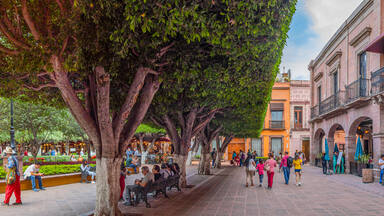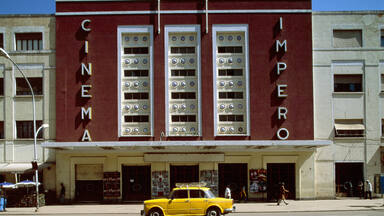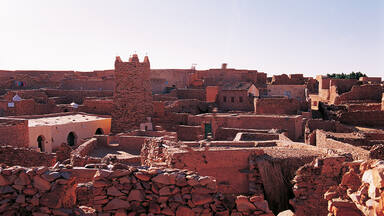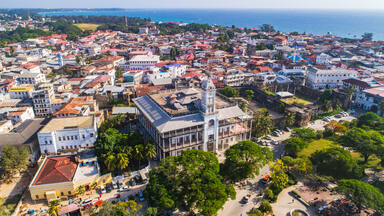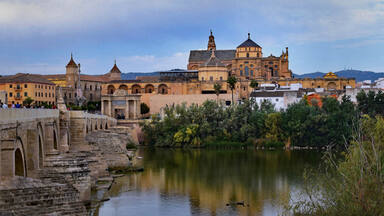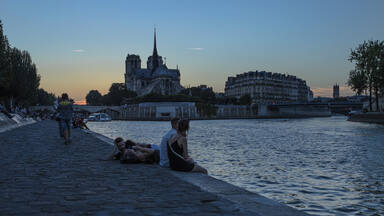"Inhabited since 250 B.C., Djenné became a market centre and an important link in the trans-Saharan gold trade. In the 15th and 16th centuries, it was one of the centres for the propagation of Islam. Its traditional houses, of which nearly 2,000 have survived, are built on hillocks (toguere) as protection from the seasonal floods."
Historical building attributes
Nearly all of the buildings in the town, including the Great Mosque, are made from sun-baked earthen bricks, which are coated with mud plaster from the river. The adobe bricks are made on the riverbank using a wooded mould and a mixture of earth and chopped straw.
The style of the monumental two-storey houses is influenced by Moroccan architecture (1591) and later marked by the Toucouleur Empire. The entrances are decorated with the “potige”, a motif assuming different configurations and indicating the position of the front door.
Toucouleur facades present an awning above the door, while Moroccan facades are heavily ornamented, without an awning. With one or the other of the two facades, the houses of Djenné are presented as works of a rigorous composition reflecting the social organisation, sometimes establishing a separation of the women and the men and men and organising the built space according to the social status of the occupants.
"Faced with the difficulties of maintaining the houses, the hostility of the new rich towards the houses made of banco, an indifferent youth, and insensitive to the cultural heritage, the Cultural Mission of Djenné has difficulty managing the property "Ancient cities of Djenné". The pronounced taste of certain inhabitants for modern houses (kitchen, interior toilet) is rising. On the eve of the Sustainable Development Goals (SDGs), heritage must become the basis of the harmonious development of the city. Therefore, it is necessary to consider how to modernise the banco houses while keeping the style and the Outstanding Universal Value (OUV) of the World Heritage property."
Attributes of urban elements
The older area of Djenné extends over 48.5 ha and is divided into ten districts. Its central avenue cuts through the dense quarters with dwindling streets. The market square, located next to the Great Mosque, is the heart of the town. The mosques and the Tombs of the Saints bear witness to the importance of the site for Islamic traditions. At the same time, many Quranic schools in urban areas attract students from outside the region.
"The city of Djenné has become a modern city with new facilities and a new society where socio-economic and environmental dynamics are perceptible. The character of a booming urban centre and the evidence of the immense resources of its heritage seem at first sight to be contradictory and incompatible. There is this perception among some inhabitants who feel they are victims of a conservatism that deprives them of the benefits of modern, comfortable urban development on the one hand and the other hand, the supporters of dynamic conservation of the city and its exceptional secular earthen architecture to be preserved at all costs. In the current development projects and programs, the tendency is to privilege the construction of basic infrastructures first and then to consider conserving a heritage whose Outstanding Universal Value is recognised through its inscription on the UNESCO World Heritage List.
In 1988, when the World Heritage Committee inscribed the property on the World Heritage List, the population of Djenné was estimated at approximately 9737 inhabitants. In 2015, this population reached 42,895 inhabitants, with a growth rate of 4.9%. Such rapid growth requires new actions for the new needs of the population. Today, the city is experiencing exponential urbanisation. The demographic pressure induces a strong demand for space for housing and other amenities of urban life. Houses in Djenné contain indoor toilets, modern kitchens, and flower pots in the windows.
An integrated urban development approach for Djenné must be designed and implemented, starting with the priority management of the earthen architectural heritage to implement integrated and inclusive development projects and programs for the millennium city. This approach is urgent, given the threats caused by the anarchic and uncoordinated interventions that are increasingly observed within the ancient fabric."
Interactive mapping
Use the interactive mapping tool to explore the different layers that compose Djenné's urban heritage. Browse through the tabs to navigate through the different scales of the city and the attributes of its urban heritage identity. Expand the legend on the bottom right corner to discover more. Click on the areas and icons to open pop-ups and learn more about the different areas and buildings.
Attributes of the wider setting of the city or settlement
The Delta of the Niger and Bani
"The annual flooding by the Niger and its tributaries is an essential natural phenomenon in both the region of Djenné and the whole inland delta area. The floods cover all but some hillocks; these are called toguéré.(...) The city of Djenné (...) spreads over several toguéré. (...) Special mention should be made of the ports of Djenné (...), where pirogues from Timbuktu would tie up."
pages 2-3.
The town finds its place within a water system constituted of the tributaries of the Bani River (4km to the East) and the Niger River (35km to the North). Djenné inhabitants own to the rivers both the prosperity of the trade routes granted by fluvial transportation and the city's urban characteristics. The city, built over several toguéré, is surrounded by water during the flood season.
The area has been continuously occupied since at least 250 B.C. Significant archaeological remains have been found in the toguéré of the delta, including “many domestic structures – walls, houses, the remains of ovens – and a wealth of metal and terracotta artefacts”. There is a coherent ensemble formed by the city of Djenné and its surrounding landscape of tells, swamps and archaeological remains.
Intangible heritage values
There are strong linkages between tangible and intangible heritage, including traditional oral expressions, social practices and associated knowledge. The weekly Monday market, when buyers and sellers converge on the town from the surrounding regions, is a key attraction. In addition, religious festivals and cultural manifestations related to Islamic culture bring locals and visitors together. These include the annual plastering of the mosque and the Tabaye-ho (river festival), which provides hunting and pirogue competitions. Traditional economic activities include woodworking, furniture making, metal processing, clothing, leather and textile. Artisanal production is concentrated in the tendehu (traditional ateliers / vestibules).
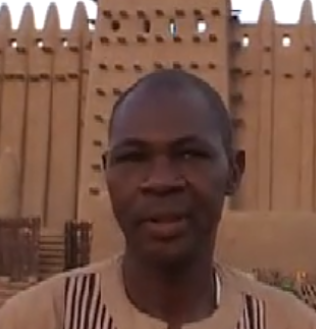
Djenné's earthen architecture
Contribution by Mr Moussa Moriba Diakité, head of the Cultural Mission of Djenné and site manager
Located 130 km southwest of the regional capital of Mopti, the city of Djenné has seen the birth and development of several civilisations and cultures, including the unique urban civilisation of Djenné Djeno, founded in the 3rd century B.C.
The current city of Djenné was founded in the 8th century and played a role as a cultural, economic, and administrative metropolis over the centuries due to the trans-Saharan trade. The city was a transportation node for the offloading of trading goods. It owed its wealth to its strategic position by the Bani River, one of the tributaries of the Niger, on the edge of the Inner Niger Delta. The Delta is a vast flood plain of 30,000 km2 known as Pondo by the Bozo people. This floodplain, rich in natural resources, particularly fertile land, water, fish, and pasture, especially the bourgou (Echinocloa Stagina), attracted several ethnic groups throughout the ages.
During the colonial period, the city lost its power as a commercial and administrative centre to Mopti, the regional capital founded by French settlers in the early 20th century. The situation of the city was negatively affected by the recurrent droughts of the 1970s and 1980s, which gradually disadvantaged the population, whose activities depended on suitable rainfall.
Even after the progressive abandonment and impoverishment of the city, the outstanding earthen architecture of Djenné stands as a testament to the former wealth and power of the city. This architecture was one of the criteria for its inscription on the UNESCO World Heritage List in December 1988 and its classification as a national heritage site in 1992. The exceptional character of this architecture and its good preservation over centuries served as inspiration for French engineers and architects, who mirrored elements of this architectural style in the construction of public buildings in cities such as Segou and Bamako.
This earthen architecture, which had been so well preserved for centuries, is beginning to fall into ruin, given the ongoing changes and the impoverishment of the population.
Djenné's earthen architecture has an indigenous origin, based on local materials such as clay and wood. It is the result of the synthesis of contributions from different cultures and traditions and the know-how of the masons of Djenné, the "bari", whose origins date back to the 15th century. One of the characteristics of the earthen architecture of Djenné is the presence of decorative elements on the façade and the plasticity of the elements, which give the buildings their own identity.
The most expressive example of this architecture is the mosque of Djenné, the largest earthen structure in the world. This exceptional example of earthen architecture has positively influenced West African building techniques, as seen in the mosques of Bobo Dioulasso (Burkina Faso), Larabanga (in the north of Ghana), Kong and Odienné in Côte d'Ivoire and many others in Mali such as those of Mopti, Niono, San and M'Pessoba, amongst others.
Following the Sudanese style, the work of the masons of Djenné showcases oriental influences, the fruit of the Moroccan occupation that took place in the 16th century and the Islamisation of the population. This influence is evident in the solid wood doors characterised by decorative motifs in wrought iron or tinplate and the moucharabieh of the windows, carved in wood and painted in red or green.
The earthen architecture of Djenné has reached our days in all its magnificence thanks to traditional conservation. This conservation is owed to the traditional masons grouped in a corporation called the barey ton, whose origin dates to the 15th century.
The "Barey ton", Association of masons of Djenné
The architecture of Djenné is the collective work of a corporation of masons known as Barey-ton. Its style made Arab chroniclers from the 15th century and European explorers in the 18th and 19th centuries. From generation to generation, these masons produced mosques and monumental houses characterised by extremely ornate facades.
The working equipment of the Djenné mason is very simple: a trowel, a hatchet, a traditional ladder made from the Borassus palm trees, and a basket to carry the banco. Most of the work is done by hand.
The "Barey ton" has the following objectives:
- to encourage sustainable economic, social and cultural development for local communities;
- to protect and promote the earthen architectural heritage;
- to ensure suitable sanitation and hygiene infrastructure.
References
- Republic of Mali, Ministry of Culture. (2008). Plan de Conservation et de Gestion des « Villes anciennes de Djenné »—Mali [ Conservation and Management Plan for the “Ancient Cities of Djenné”—Mali ]. https://whc.unesco.org/document/102566 (In French.)
- Republic of Mali, Ministry of Culture, National Direction of Cultural Heritage. (2019). « Villes anciennes de Djenne » plan de gestion et de conservation (2018-2022), ["Old towns of Djenne" management and conservation plan (2018-2022)]. https://whc.unesco.org/document/174276 (In French.)
- World Heritage Committee, 35th session. (2011). Decision 35 COM 8E. Adoption of retrospective Statements of Outstanding Universal Value. https://whc.unesco.org/en/decisions/4408/
- World Heritage Committee, 35th session. (2011). Document WHC-11/35.COM/8E Adoption of retrospective Statements of Outstanding Universal Value https://whc.unesco.org/document/106679
- World Heritage Nomination Dossier 116Rev. (1987). UNESCO Archives.
Links
- Old Towns of Djenné, inscribed on the World Heritage List (1987).
- Cultural practices and expressions linked to the 'M’Bolon', a traditional musical percussion instrument, inscribed on the List of Intangible Cultural Heritage in Need of Urgent Safeguarding (2021).
- Secret society of the Kôrêdugaw, the rite of wisdom in Mali, inscribed on the List of Intangible Cultural Heritage in Need of Urgent Safeguarding (2011).
- Sanké mon, collective fishing rite of the Sanké, inscribed on the List of Intangible Cultural Heritage in Need of Urgent Safeguarding (2009).
- Cultural space of the Yaaral and Degal, inscribed on the Representative List of the Intangible Cultural Heritage of Humanity (2005, 2008).
Decisions / Resolutions (2)
The World Heritage Committee,
1. Having examined Document WHC-11/35.COM/8E,
2. Adopts the retrospective Statements of Outstanding Universal Value, as presented in the Annex I of Document WHC-11/35.COM/8E, for the following World Heritage properties:
- Afghanistan: Minaret and Archaeological Remains of Jam; Cultural Landscape and Archaeological Remains of the Bamiyan Valley;
- Bahrain: Qal'at al-Bahrain - Ancient Harbour and Capital of Dilmun;
- Benin: Royal Palaces of Abomey;
- Botswana: Tsodilo;
- Cameroon: Dja Faunal Reserve;
- Central African Republic: Manovo-Gounda St Floris National Park;
- China: Three Parallel Rivers of Yunnan Protected Areas;
- Germany: Upper Middle Rhine Valley;
- India: Manas Wildlife Sanctuary;
- Kenya: Lake Turkana National Parks; Lamu Old Town;
- Malawi: Chongoni Rock-Art Area;
- Mali: Old Towns of Djenné;
- Pakistan: Fort and Shalamar Gardens in Lahore;
- Peru: Chan Chan Archaeological Zone;
- Philippines: Rice Terraces of the Philippine Cordilleras;
- Senegal: Island of Saint-Louis;
- South Africa: iSimangaliso Wetland Park; Robben Island; Mapungubwe Cultural Landscape; Cape Floral Region Protected Areas; Vredefort Dome;
- Togo: Koutammakou, the Land of the Batammariba;
- Turkey: Historic Areas of Istanbul;
- Uganda: Bwindi Impenetrable National Park; Rwenzori Mountains National Park;
- United Republic of Tanzania: Ruins of Kilwa Kisiwani and Ruins of Songo Mnara;
- Yemen: Old Walled City of Shibam; Old City of Sana'a;
- Zimbabwe: Mana Pools National Park, Sapi and Chewore Safari Areas;
3. Decides that retrospective Statements of Outstanding Universal Value for World Heritage properties in Danger will be reviewed in priority;
4. Further decides that, considering the high number of retrospective Statements of Outstanding Universal Value to be examined, the order in which they will be reviewed will follow the Second Cycle of Periodic Reporting, namely:
- World Heritage properties in the Arab States;
- World Heritage properties in Africa;
- World Heritage properties in Asia and the Pacific;
- World Heritage properties in Latin America and the Caribbean;
- World Heritage properties in Europe and North America.
Wet Tropics of Queensland
486
Australia
N(i)(ii)(iii)(iv)
In accordance with the wishes of the Bureau at its last meeting in June 1988, the Committee noted that the Bureau had re-examined this nomination taking into account the revised evaluation of IUCN and additional information provided by Australia, as requested by the Bureau. Following this re-examination, the Committee decided to inscribe this property on the World Heritage List. It recommended that an appropriate management regime be established. The Committee furthermore recommended that IUCN continue to monitor the status of conservation of this property and report back to the Committee in the next 2 to 3 years.
Read more about the decision